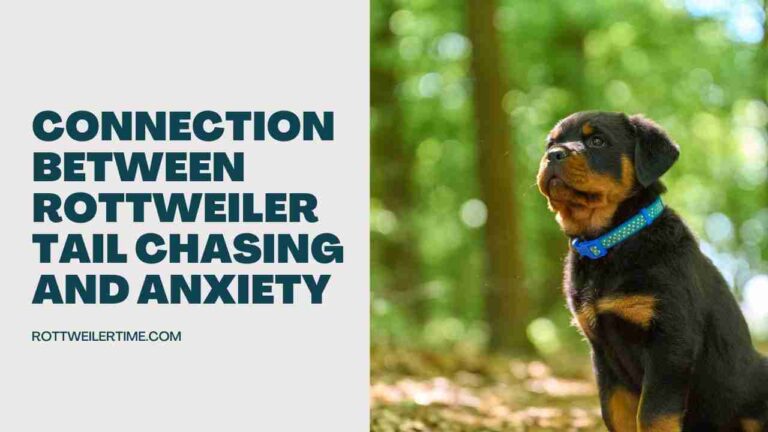When it comes to our beloved four-legged friends, such as Rottweilers, it’s important to pay attention to their behavior and understand the underlying reasons behind certain actions.
One behavior that can be perplexing to Rottweiler owners is tail chasing. In this article, we will explore the connection between Rottweiler tail chasing and anxiety.
Understanding this connection can help us address the issue effectively and ensure the well-being of our furry companions.
Contents
- 1 What is Tail Chasing?
- 2 Signs of Anxiety in Rottweilers
- 3 The Link Between Tail Chasing and Anxiety
- 4 Cause and Effect Relationship
- 5 Anxiety as the Underlying Cause
- 6 Addressing Rottweiler Tail Chasing and Anxiety
- 7 Seek Professional Guidance
- 8 Provide a Safe and Enriched Environment
- 9 Implement Positive Reinforcement Training
- 10 Consider Anxiety-Reducing Strategies
- 11 FAQs (Frequently Asked Questions)
- 12 Conclusion
What is Tail Chasing?
Tail chasing is a repetitive behavior where a Rottweiler constantly spins in circles, attempting to catch their own tail.
This behavior is commonly observed in Rottweilers and can sometimes be mistaken for a playful act. However, it is important to recognize that tail chasing can be an indicator of an underlying issue, such as anxiety.
Signs of Anxiety in Rottweilers
Anxiety in Rottweilers can manifest in various ways. Some common signs include excessive panting, pacing, restlessness, destructive behavior, and loss of appetite. Tail chasing can be one of the signs that your Rottweiler is experiencing anxiety.
It is essential to observe your dog’s behavior closely and look for any other signs of anxiety to gain a better understanding of the situation.
The Link Between Tail Chasing and Anxiety
Cause and Effect Relationship
Tail chasing is often a self-reinforcing behavior, meaning that the more a Rottweiler engages in tail chasing, the more likely they are to continue doing it.
This behavior can be triggered by anxiety or stress, and the act of tail chasing itself can provide a temporary distraction or relief from those emotions.
However, it is important to note that this relief is short-lived and does not address the underlying cause of anxiety.
Anxiety as the Underlying Cause
Rottweilers are known to be sensitive and intelligent dogs. They can easily pick up on their owners’ emotions and respond to environmental changes.
Various factors can contribute to anxiety in Rottweilers, such as a change in routine, separation from their owners, loud noises, or past traumatic experiences.
Tail chasing can be a coping mechanism for these anxious feelings, providing a temporary outlet for their stress.
Addressing Rottweiler Tail Chasing and Anxiety
Seek Professional Guidance
If you suspect that your Rottweiler’s tail-chasing behavior is linked to anxiety, it is crucial to consult with a professional, such as a veterinarian or a certified dog behaviorist.
They can assess your dog’s behavior, diagnose the underlying cause of anxiety, and recommend appropriate interventions.
Provide a Safe and Enriched Environment
Creating a safe and enriched environment for your Rottweiler is essential in managing anxiety. Ensure that your dog has a designated space where it can retreat and feel secure. Engage in regular exercise and playtime to help alleviate stress.
Additionally, provide mental stimulation through interactive toys and training activities to keep their minds occupied.
Implement Positive Reinforcement Training
Positive reinforcement training techniques can be beneficial in redirecting your Rottweiler behavior. Reward desirable behaviors, such as calmness and relaxation, to reinforce a positive association.
Engage in obedience training to establish boundaries and provide your Rottweiler with a sense of security and structure.
Consider Anxiety-Reducing Strategies
There are various anxiety-reducing strategies that can help alleviate your Rottweiler symptoms. These may include the use of calming pheromone diffusers, anxiety wraps, or natural supplements.
However, it is essential to consult with a professional before implementing any new strategies to ensure they are safe and appropriate for your dog.
FAQs (Frequently Asked Questions)
1. Can all Rottweilers experience tail chase as a result of anxiety?
While tail chasing can be linked to anxiety in Rottweilers, not all instances of tail chasing are necessarily caused by anxiety. It’s important to assess the overall behavior and look for other signs of anxiety before concluding that tail chasing is anxiety-related.
2. How can I differentiate between playful tail chasing and anxiety-related tail chasing?
Playful tail chasing is often accompanied by a relaxed body posture, a wagging tail, and an overall playful demeanor. Anxiety-related tail chasing, on the other hand, may be accompanied by signs of stress, such as panting, restlessness, and avoidance behavior.
3. Should I try to stop my Rottweiler from tail chasing altogether?
It is important to address the underlying cause of the tail chasing rather than focusing solely on stopping the behavior itself. By addressing anxiety and providing appropriate interventions, the tail-chasing behavior may naturally decrease or cease.
4. Can medication be helpful in treating anxiety-related tail chasing?
In some cases, medication prescribed by a veterinarian may be beneficial in managing anxiety-related behaviors. However, medication should always be used under the guidance and supervision of a professional.
5. How long does it take to see improvement in anxiety-related tail chasing?
The timeline for improvement can vary depending on the individual dog and the underlying causes of anxiety. Consistency in implementing behavioral interventions, along with patience and professional guidance, can help in achieving positive results over time.
Conclusion
Meet the Author Mehmood Shah,
As an owner of Rottweiler for 10 years, I motivate and encourage people about this lovely breed.
We’re dedicated to providing you the detailed researched articles about Rottweiler, with an emphasis on Rottweiler Health, Training, and Exercises.
I started my journey with Rottweiler Time in 2021 and it has come a long way from its beginnings.
Thanks for Your Support.


